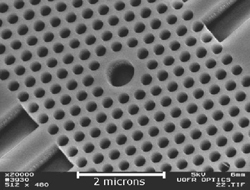Ultrasensitive Optical Detection of Viruses with Silicon 2-D Photonic Bandgap Structures
Direct single- or near-single copy detection of viruses is an important challenge in human health. Applications include the need to monitor emerging viral threats (H5N1 influenza and the SARS virus, for example), and the importance of understanding the long-term implications of nearly undetectable reservoirs of infection following antiretroviral therapy for HIV. While considerable effort has been expended on the development of ultrasensitive detection methods, the need remains for new technologies that are exceptionally sensitive, label-free, physically robust, and highly selective for particular viruses of interest.
We hypothesize that two-dimensional photonic bandgap (2DPBG) sensors can fulfill all of these requirements. These micron-scale devices, fabricated in silicon, are capable of detecting single virus-sized particles. In collaboration with the Fauchet and Yates labs, we are developing novel methods for rendering these devices sensitive to specific pathogens. We are also integrating these sensors into full lab on a chip
type systems.

SEM image of a 2-D bandgap device for virus sensing.
Researcher: Benjamin L. Miller, Ph.D.
Carbohydrate and protein recognition, molecular design, and biomolecular sensing
